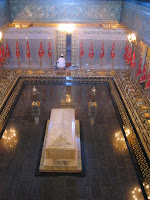This post does not contain any photos of dying, butchered, or otherwise dismembered animals.
Eid al Adha is one of the most important days on the Islamic calendar, and thus it's a major holiday in Morocco and across the world. Apparently, in the US, some people think it's heresy for Best Buy to acknowledge an event that up to a billion people celebrate. Based on my limited conversations with Moroccans, the number of sheep I saw in Rabat, and the nature of the sacrifice, I don't believe that a current of opposition to sacrificing animals is running with any noticeable force, in case anyone is curious. In fact, national television showed Mohammad VI slitting the throat of an immaculate ram on the nightly news program.
Thanks to the generosity of a Qalam wa Lawh staffer, Loubna, I was set-up with a host family for Eid al Adha with Loubna and her husband Hassan. The day started early with an 8:30 pick up near my apartment, followed by another stop to retrieve Feriha, an Indiana ME Studies PhD
 student. I purchased a pretty cake yesterday and brought it with as a token of my appreciation and an attempt to contribute something. Hassan and Loubna, along with Hassan's family, secured two sheep for the sacrifice and meal. The sheep are expensive and it's not easy adding two guests into a family event with little notice, so I am appreciative of their kindness.
student. I purchased a pretty cake yesterday and brought it with as a token of my appreciation and an attempt to contribute something. Hassan and Loubna, along with Hassan's family, secured two sheep for the sacrifice and meal. The sheep are expensive and it's not easy adding two guests into a family event with little notice, so I am appreciative of their kindness.I won't belabor the issue with grizzly details of the killing, caping, or gutting. A butcher ran the
 knives and efficiently killed five sheep, and there was nothing approaching cruel practices. (One could object that the entire process is cruel and thus relative cruelty or concern for suffering is inconsequential. I might disagree.) There was no chanting, laughing, or any boisterous mirth. It was reverential, especially if you compare it to US slaughterhouses. In fact, I would characterize it as businesslike. Following the sacrifice of five sheep, the group moved downstairs for tea and cookies. Of course, what's a better post-slaughter snack?
knives and efficiently killed five sheep, and there was nothing approaching cruel practices. (One could object that the entire process is cruel and thus relative cruelty or concern for suffering is inconsequential. I might disagree.) There was no chanting, laughing, or any boisterous mirth. It was reverential, especially if you compare it to US slaughterhouses. In fact, I would characterize it as businesslike. Following the sacrifice of five sheep, the group moved downstairs for tea and cookies. Of course, what's a better post-slaughter snack?A freshly butchered animal doesn't move from knife to oven in one fell swoop, so we did not consume the bulk of the meat. Loubna and her mother-in-law prepared the liver, heart, and, possibly, gall bladder along with fresh bread. The eating was spread over several hours and finished with a lemon chicken with a cascade of french fries. The liver is wrapped with fat and grilled as brochettes (aka shish kabobs) along with the heart. I enjoyed the heart and most of my fatty liver was a delight, but a few a pieces tasted a bit unusual. Overall, especially with fresh baked bread, Loubna's cooking left me quite satisfied. What I presume was a gall bladder (they weren't sure about an English translation), was prepared on the stove with cumin and a couple of other spices that I could not place. Although Loubna cooked it thoroughly, it retained a spongey consistency. I followed Hassan's lead and cut a piece of bread in two and fashioned a sandwich of olives and organ. The olives' flavor along with the spices of the gall bladder merged amazingly and was, by far, one of my most favorite meals of the day.
In some ways, I regret missing the chance to eat the head and hooves. Feriha wanted to leave by four and I could not arrange another ride, plus I was stuffed and I found the prospect of continued eating daunting. In fact, as I write this the next morning, I'm still not hungry. Loubna, Hassan, and Hassan's family welcomed me and seemed to enjoy having us present. At one point, someone even handed me a two or so year old girl to hold after meeting me for all of twenty minutes. I'm thrilled to celebrate Eid as this was most likely a once in a lifetime opportunity and a cultural event that is hardly available to me in the States.
















































